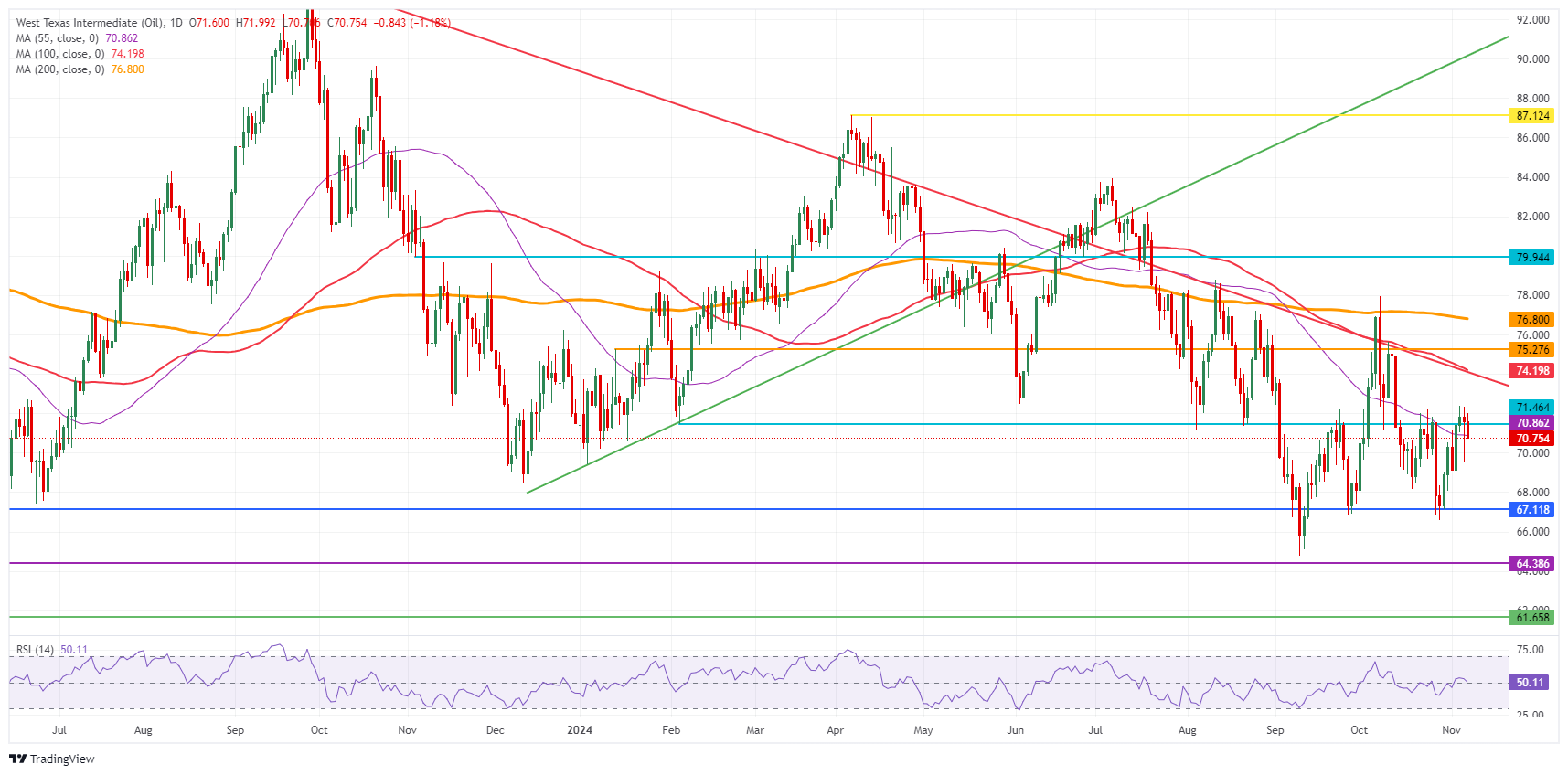- Crude Oil retraces for the second straight day, losing over 1% on Thursday.
- Storm Rafael disrupts short-term US Oil output while Trump is set to boost shale production substantially.
- The US Dollar Index fades under profit-taking as markets now focus on the Fed interest rate-cutting cycle.
Crude Oil dips for a second day in a row on Thursday as commodity traders assess the impact of the Trump trade on Oil prices in the long term. US President-elect Donald Trump has vowed to boost shale Oil production in the US, which would add more barrels of Oil to the markets. Meanwhile, the tropical storm Rafael is set to take out roughly 1.55 million barrels per day in production as of Friday.
The US Dollar Index (DXY), which tracks the performance of the Greenback against six other currencies, is fading under profit-taking from the steep rally that materialized after President-elect Donald Trump won the US presidential election over current Vice President Kamala Harris. Expect the focus now to dial down on Trump’s presidency until he takes office in January 2025, with the focus back on US economic numbers and the Federal Reserve (Fed), which is expected to cut its monetary policy rate by 25 basis points this Thursday.
At the time of writing, Crude Oil (WTI) trades at $70.73 and Brent Crude at $74.23
Oil news and market movers: Oil outlook gets distorted again
- Tropical storm Rafael is hitting the shores of Cuba, making its way to the US Gulf region, Reuters reports.
- Oil imports into China sank again last month, highlighting the sluggish consumption in the largest consuming country while traders weigh the implications of Donald Trump capturing the White House and potential supply rises from OPEC+ in 2025, Bloomberg reports.
- On Wednesday, the Energy Information Administration (EIA) reported a surprise build of 2.149 million barrels in the week ending on November 1, bigger than the expected 1.8 million. The previous week’s number was a drawdown of 0.515 million barrels.
Oil Technical Analysis: ‘Leave the Oil to Me’
Crude Oil prices could be set for a bear cycle as Donald Trump is set to become the next US President in January 2025. Trump has already committed in the runup to the presidential election that regulation and permitting will become less strict. At the same time, funds allocated to green energy will be diverted towards shale Oil and fossil fuel projects. That means structural additional supply is set to be released in 2025, on top of OPEC+’s foreseen supply normalization.
On the upside, the hefty technical level at $74.20, with the 100-day Simple Moving Average (SMA) and a few pivotal lines, is the next big hurdle ahead. The 200-day SMA at $76.80 is still quite far off, although it could get tested in case tensions in the Middle East arise.
The 55-day SMA at $70.86, has lost control of the situation and no longer supports prices while being chopped up intraday. Traders need to look much lower at $67.12, a level that supported the price in May and June 2023. In case that level breaks, the 2024 year-to-date low emerges at $64.75, followed by $64.38, the low from 2023.
US WTI Crude Oil: Daily Chart
WTI Oil FAQs
WTI Oil is a type of Crude Oil sold on international markets. The WTI stands for West Texas Intermediate, one of three major types including Brent and Dubai Crude. WTI is also referred to as “light” and “sweet” because of its relatively low gravity and sulfur content respectively. It is considered a high quality Oil that is easily refined. It is sourced in the United States and distributed via the Cushing hub, which is considered “The Pipeline Crossroads of the World”. It is a benchmark for the Oil market and WTI price is frequently quoted in the media.
Like all assets, supply and demand are the key drivers of WTI Oil price. As such, global growth can be a driver of increased demand and vice versa for weak global growth. Political instability, wars, and sanctions can disrupt supply and impact prices. The decisions of OPEC, a group of major Oil-producing countries, is another key driver of price. The value of the US Dollar influences the price of WTI Crude Oil, since Oil is predominantly traded in US Dollars, thus a weaker US Dollar can make Oil more affordable and vice versa.
The weekly Oil inventory reports published by the American Petroleum Institute (API) and the Energy Information Agency (EIA) impact the price of WTI Oil. Changes in inventories reflect fluctuating supply and demand. If the data shows a drop in inventories it can indicate increased demand, pushing up Oil price. Higher inventories can reflect increased supply, pushing down prices. API’s report is published every Tuesday and EIA’s the day after. Their results are usually similar, falling within 1% of each other 75% of the time. The EIA data is considered more reliable, since it is a government agency.
OPEC (Organization of the Petroleum Exporting Countries) is a group of 12 Oil-producing nations who collectively decide production quotas for member countries at twice-yearly meetings. Their decisions often impact WTI Oil prices. When OPEC decides to lower quotas, it can tighten supply, pushing up Oil prices. When OPEC increases production, it has the opposite effect. OPEC+ refers to an expanded group that includes ten extra non-OPEC members, the most notable of which is Russia.

